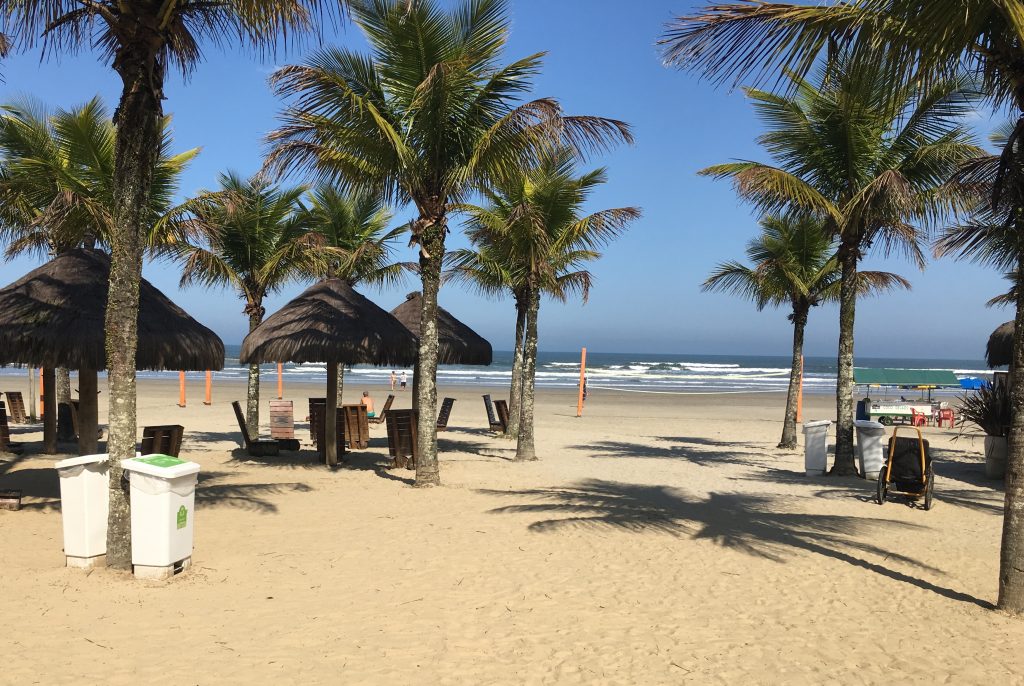Bertioga, São Paulo, Brazil
The preserve is in the middle of the town of Bertioga, a town with a population of around 60,000. It is a long and narrow municipality, hemmed in by the mountains (Serra do Mar) on one side and the Atlantic Ocean on the other. It is a place of great natural beauty, but not so much wealth. This makes it more challenging to conserve nature, since local people might want to use the forest or even occupy parts of it. This was how favelas got started in Rio with unfortunate social and ecological ramifications. The nearby picture shows the road right on one of the preserve edges and gives an idea of the possible challenge.
Partners in Preservation
SESC officials, like Juarez recognized this challenge and made it a virtue. Their philosophy is that people should be integrated into the natural community and that natural communities should be integrated into human ones, so rather than fence off the forest, SESC invited the local people to participate. They did outreach to find out what the local people thought and what they wanted. Most of the local people appreciated the forest and wanted to conserve it and they are a strong force for protection. One thing that people wanted was a community garden, which SESC helped build on the fringe of the area of conservation. There are also plans for “agro-forestry” within the preserve. This will mean that in some places there will be food for people. All this means that the people living near the forest have become partners in preservation rather than adversaries to be excluded. This is a model of how it can work.
Restoring the Magnificent Atlantic Forest
Brazil’s Atlantic forests were magnificent and parts of it still are, but since the Atlantic forests were first to be exploited and now are more densely occupied, protecting what is left is important and restoring some other what can be restored imperative.
One of the features that makes Brazil’s coast so spectacular and beautiful is that the green mountains sweep down to the sea. Among the most preciously rare in this already preciously rare ecology are the thin strips of forests between the beaches and the uplands. This is mostly flat land. If you are going to try to grow something, this is a logical place to start. If you want to build a beach front home or hotel, this is the place to do it – above the high tide and not subject to the shifting ground of the hills. SESC’s forest is on precisely this ground and it is precisely why it is surrounded by human habitation.
SESC employed scientist and naturalist to study the flora and fauna of their preserve and found it rich in the diversity of both. It is very unlikely that this forest patch was never cut, but SESC has owned it since 1947 and it has been intact at least since then. The trees rarely grow to great height, as they do farther inland, since the sandy soil does not support the kinds of root systems that can hold them up. As we walked through the wood, we saw wind throws that revealed just how shallow the root systems could be even for big trees. My guess is that this is a more ephemeral ecology. This provides some advantages for restoration. The fabled triple canopy forests take many more years to restore.
Mangroves
SESC also owns a significant amount of riparian land along the Itapanhau River estuary. Here the brackish tidal water supports mangrove thickets. Mangroves are the classic edge community. Edge ecosystems are often among the most diverse, since they combine two or more environments. They usually punch well above their weight and are crucial to the larger ecosystem they join. Mangroves are amphibious trees that grow between high and low tide. They are sensitive to frost. In the U.S., they grow only in south Florida, and a few places in Louisiana so we went to see some in the Florida Keys. The tangle of roots and branches help hold soil and protect the coast from erosion and storms. They also provide cover for fish and wildlife to breed. Mangroves are also a threatened ecosystem, since people often want to “develop” the places they occupy and the very tangle that makes them such a formidable ecology is annoying to people wanting to get around. Removing mangrove, however is almost always a mistake, as with them go the wildlife benefits mentioned above and also protection from storms. The mangroves provide a flexible and self-repairing protection that no feat of engineering can match.
Doing the Right Things for the Right Reasons Make Sustainable
I was mighty impressed with what SESC is doing. They are integrating natural and human communities into their developments from the start, as the crucial parts of the project that they are, rather than as something to be tacked on at the end. Juarez credits the long-view taken by SESC management and the resource they are willing to commit to the long term. It is a model.





